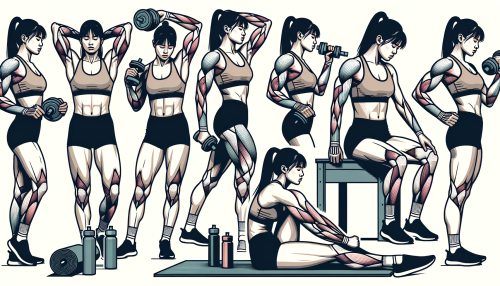Introduction
Home Workouts: Building Your Personal Fitness Space on a Budget is a comprehensive guide that provides practical and cost-effective solutions for creating a personal fitness area at home. This guide is designed to help individuals maintain a healthy lifestyle without the need for expensive gym memberships or equipment. It offers a variety of workout routines that can be performed using minimal equipment, as well as tips on how to utilize household items for exercise. The guide also includes advice on setting fitness goals, staying motivated, and ensuring safety while working out at home.
Maximizing Your Home Workout: Affordable Ways to Build a Personal Fitness Space

Home workouts have become increasingly popular, especially in the wake of the global pandemic. With gyms and fitness centers temporarily closed or operating at limited capacity, many people have turned to home workouts to maintain their fitness routines. However, building a personal fitness space at home can seem like a daunting and expensive task. But don’t worry, it’s entirely possible to create an effective workout space on a budget.
Firstly, it’s important to remember that you don’t need a lot of space to have an effective home gym. A small corner of your living room, bedroom, or even your garage can be transformed into a workout area. The key is to maximize the space you have. For instance, consider using wall-mounted racks for weights or resistance bands, or a foldable yoga mat that can be easily stored away when not in use.
Next, let’s talk about equipment. While it’s easy to get carried away with fancy gym equipment, remember that some of the most effective workouts can be done with minimal equipment. Start with the basics like a yoga mat, resistance bands, and a set of dumbbells. These items are relatively inexpensive and can be used for a wide range of exercises. As you progress and your fitness level increases, you can gradually add more equipment to your home gym.
Another cost-effective way to build your home gym is to buy used equipment. There are plenty of online platforms where you can find second-hand fitness equipment at a fraction of the cost of new ones. Just make sure to thoroughly check the condition of the equipment before making a purchase.
In addition to physical equipment, consider investing in digital resources. There are numerous fitness apps and online platforms that offer workout programs and classes for a small monthly fee, or even for free. These digital resources can provide you with a structured workout routine and help keep you motivated.
Don’t forget about the importance of ambiance in your workout space. A well-lit, clean, and inviting space can make your workouts more enjoyable. Consider adding a mirror to your workout space. Not only does it make the space look bigger, but it also allows you to check your form during workouts. You can often find inexpensive mirrors at thrift stores or discount home goods stores.
Lastly, remember that building your home gym is a process, not a one-time event. Start small and gradually add to your space as your budget allows. The most important thing is that your workout space meets your personal fitness needs and helps you stay committed to your fitness journey.
In conclusion, creating a home workout space on a budget is entirely achievable. By maximizing the space you have, starting with basic equipment, buying used items, utilizing digital resources, and creating a pleasant ambiance, you can build a personal fitness space that not only meets your fitness needs but also fits your budget. So, don’t let the cost deter you from building your home gym. With a little creativity and planning, you can have a functional and affordable workout space right in the comfort of your own home.
Budget-Friendly Tips for Creating Your Own Home Gym
Home workouts have become increasingly popular, especially in the wake of the global pandemic. With gyms and fitness centers temporarily closed or operating at limited capacity, many fitness enthusiasts have turned to home workouts to stay in shape. However, setting up a personal fitness space at home can seem like a daunting and expensive task. But don’t worry, it doesn’t have to be. With a little creativity and some budget-friendly tips, you can create your own home gym without breaking the bank.
Firstly, it’s important to remember that you don’t need a lot of space to create an effective home gym. A spare room, garage, or even a corner of your living room can be transformed into a workout area. The key is to make the space functional and comfortable for your workouts. A yoga mat, for instance, can be rolled out on the floor for exercises like yoga, pilates, or bodyweight workouts. It’s affordable, easy to store, and can be used for a variety of exercises.
Next, consider investing in versatile and affordable fitness equipment. Resistance bands, for example, are a great investment. They’re inexpensive, take up little space, and can be used for a wide range of exercises. Similarly, a set of dumbbells or kettlebells can be used for strength training and can be easily stored away when not in use. If you’re on a tight budget, you can also use household items as makeshift workout equipment. A sturdy chair can be used for step-ups or tricep dips, while canned goods can double as light hand weights.
Another budget-friendly tip is to buy used fitness equipment. Many people buy exercise machines with the best intentions, only to let them gather dust after a few uses. You can often find barely used treadmills, stationary bikes, or weight sets at a fraction of the original price on online marketplaces or at garage sales. Just make sure to thoroughly clean and disinfect any used equipment before bringing it into your home.
In addition to physical equipment, there are also plenty of free or low-cost digital resources available to guide your workouts. Numerous fitness apps and online platforms offer free workout routines, instructional videos, and even virtual classes. These can be a great way to add variety to your workouts and keep you motivated without the need for a personal trainer.
Lastly, remember that creating a home gym is a process, not a one-time event. Start small and gradually add to your fitness space as your budget allows. Even a few basic pieces of equipment can provide a solid foundation for a wide range of workouts. Over time, you can invest in more specialized equipment that aligns with your fitness goals.
In conclusion, building your personal fitness space at home on a budget is entirely possible with a little creativity and planning. By utilizing a small space effectively, investing in versatile and affordable equipment, buying used items, and taking advantage of free digital resources, you can create a home gym that suits your needs and helps you stay fit without straining your wallet. So, roll out that yoga mat, grab those resistance bands, and get ready to sweat in the comfort of your own home.
Achieving Fitness Goals at Home: How to Build a Cost-Effective Workout Space
Home workouts have become increasingly popular, especially in the wake of the global pandemic. With gyms and fitness centers temporarily closed or operating at limited capacity, many people have turned to home workouts to maintain their fitness routines. But how can you create an effective workout space at home without breaking the bank? Let’s explore some cost-effective ways to build your personal fitness space.
Firstly, it’s important to remember that you don’t need a dedicated room or a large space to create a home gym. A corner of your living room, bedroom, or even your garage can serve as your workout area. The key is to make the space functional and comfortable for your workouts. A yoga mat, for instance, can transform any floor into a suitable workout area. It’s not only affordable but also easy to store and clean.
Next, consider investing in versatile fitness equipment. While it might be tempting to splurge on a high-end treadmill or a fancy weight set, these items can be quite expensive and take up a lot of space. Instead, opt for multipurpose fitness tools like resistance bands, a stability ball, or adjustable dumbbells. These items are not only budget-friendly but also offer a wide range of exercise options, allowing you to target different muscle groups and switch up your workouts to keep them interesting.
Another cost-effective way to build your home gym is to buy used fitness equipment. Many people buy gym equipment with good intentions but end up not using them. As a result, you can often find barely used equipment for sale at a fraction of the original price. Check out online marketplaces, garage sales, or even your local thrift store. Just make sure to thoroughly clean and disinfect any used items before using them.
In addition to physical equipment, consider digital resources. There are countless fitness apps and online platforms offering free or low-cost workout programs. These resources can guide you through different workouts, track your progress, and even provide virtual coaching. They’re a great way to add variety to your workouts and keep you motivated without the need for expensive personal trainers or gym memberships.
Lastly, don’t underestimate the power of DIY. With a little creativity and some basic DIY skills, you can create your own fitness equipment. For example, fill up water bottles to use as weights, or use a sturdy chair for step-ups and tricep dips. There are plenty of online tutorials to guide you in making your own equipment, saving you money while adding a personal touch to your home gym.
Building a home gym doesn’t have to be expensive. With some strategic planning and smart choices, you can create a functional and effective workout space that suits your fitness needs and budget. Remember, the goal is to create a space that encourages you to stay active and maintain a regular fitness routine. So, focus on what works for you, whether that’s a simple yoga mat in the corner of your room or a more elaborate setup with various fitness equipment. With your own personal fitness space, achieving your fitness goals at home becomes not just possible, but enjoyable and affordable too.
Conclusion
In conclusion, building a personal fitness space on a budget for home workouts is a feasible and beneficial endeavor. It allows for flexibility in workout schedules, saves money in the long run, and can be tailored to personal fitness needs and goals. With careful planning, budgeting, and creativity, one can effectively create a functional and efficient workout space at home.





